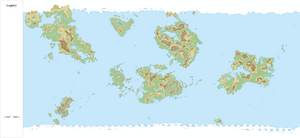IxWiki:Global Maps
This article is non-canonical either because it refers to out-of-character content, the associated nations have left the region, or the information has been retconned. Accordingly, its content should not be considered to be part of the canonical structure of the region's lore.
|
The various Global Maps World Map, Continents Map, Raw Map, Topographic Map, and Climate Map (in progress) are the graphical representation of the world in which we RP. Each map represents the same view but display specifically pertinent information that help us describe the world.
To make our world compatible with our ability to communicate about it we have to make some broad handwavium assumptions. They fall into the following categories:
- the size and scale of out world and how we measure it
- the way climate and weather works; and
- the way tectonics and physical geography are (not) related.
Size and Scale
As of 4/11/2021 the base map that all global maps display is 8,202 pixels long and 4,900 pixels in height. The scale of these maps is 1px=10sqmi (25.90 sqkm). This means that the circumference of this world is 42,020 miles making our world 1.688 times larger than Earth. We have collectively agreed that, for RPing purposes, this will not have an impact of the gravity of our world.
The world map is bound by the polar circles and represents the habitable land in our world. The gray/raw map includes these polar zones.
Calculating Latitude and Longitude

To make it 1:1 analogue longitude lines would be 45.5666px and latitude lines would be 13.6111px.
To calculate a coordinate, you need understand that the Equator is in the middle of the map height-wise at 2450 pixels from the top and the Prime Meridian is in the middle of the map width-wise at 4101 pixels from the left. Open the Raw map in a program that tells me which pixels you are pointing to. I use Paint.net because its free, but Photoshop and other programs are just fine. The image to the right shows you where to find that information in Paint.net using the regular pointer tool.
Longitude
To determine the longitude of a location look at the first number in the bottom right, in the example 5286. Since it is greater than 4101 that means it is east of the Prime Meridian. To determine how many degrees east of the Prime Meridian subtract 4101 from 5286 equaling 1185. Because there are 45.5666px in each line of longitude, divide 1185 by 45.5666, equaling 26.005. This is the number of decimal degrees east of the Prime Meridian the point is, written as 26.005E.
Latitude
To determine the latitude of a location look at the second number in the bottom right, in the example 1605. Since it is less than 2450 that means it is north of the Equator. To determine how many degrees north of the Equator subtract 1605 from 2450 equaling 845. Because there are 13.6111px in each line of latitude, divide 845 by 13.6111, equaling 62.081. This is the number of decimal degrees north of the Equator the point is, written as 62.081N.
Converting decimal degrees to degrees minute and seconds
This is an optional step. To convert these into geographic coordinates click this link to the Degrees Minutes Seconds to/from Decimal Degrees calculator and scroll to the second calculator, titled Decimal Degrees to Degrees Minutes Seconds. Input your decimal latitude in the first box, in this example 62.081, and your decimal longitude in the second box, in this example 26.005. It will output your coordinates in degrees minutes and seconds. In this example 62° 4' 51.6" and 26° 0' 17.9994". Now to complete the coordinates you need to give them their hemispheric references (North or South of the Equator, and East or West of the Prime Meridian). In this case because we know that this example is from north of the Equator and West of the Prime Meridian we would complete it as follows: 62° 4' 51.6"N and 26° 0' 17.9994"E. I choose to take out the superfluous decimals because they are far too specific for references in this world. I am not trying to locate a pinhead, I am pointing to a city, or town most likely.
Comparing to IRL latitudes and longitudes
If you would like to see how your coordinates compare to the real world you can put your decimal or minutes and second degrees into GPS Coordinate calculator and interactive map.
Climate and weather
Based on general latitudinal observations analogues with IRL climates can be made. Check the Discord Map channel for a pinned message about how to fill this in.
Tectonics and Physical Geography
